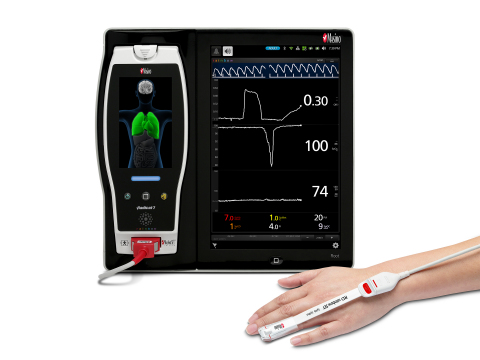New Study Investigates the Ability of Masimo ORi™ to Provide Early Warning of Hypoxemia During Endotracheal Intubation in ICU Patients
Researchers Found That Use of ORi May Facilitate “Preventive Action” Against Hypoxemia

Masimo Root® with ORi™ (Photo: Business Wire)
ORi, available outside the
Noting the importance of optimizing preoxygenation in patients needing ETI, the researchers sought to evaluate whether ORi could provide early warning of impending hypoxemia during the procedure, because ORi “supplies information beyond the range explored by SpO2.” Of the 51 patients who met the inclusion criteria, ORi (alongside SpO2) was monitored using Masimo Radical-7® Pulse CO-Oximeters® and rainbow® fingertip sensors when preoxygenation began. Values were recorded every two seconds, and attending clinicians were not aware of these values. The primary endpoint measured was the time between ORi decreasing below 0.4 and the onset of mild hypoxemia (defined as SpO2 <
Analyzing areas under the ROC curve, the researchers found that ORi during preoxygenation predicted SpO2 <
The researchers concluded, “The median time between the ORi decrease below 0.4 and the SpO2 decrease below
The researchers noted that the median 81 seconds of forewarning “may allow immediate intubation, early face-mask ventilation, insertion of a supraglottic device, or a call for help in the event of intubation difficulties.” In addition, they noted that “ORi monitoring can help identify patients who do not increase their oxygen reserve despite preoxygenation and are therefore at [increased] risk of desaturation during ETI. These patients may benefit from a longer preoxygenation period and/or a change in device.” The authors further noted that “an ORi decline might lead to the detection of a fault in the preoxygenation technique such as an insufficient oxygen flow rate or major leaks.”
As a study limitation, the authors noted that their findings cannot be generalized to ICU patients who did not meet the inclusion criteria, as those patient cohorts remain to be evaluated. The inclusion criteria for this study were ICU admission with a need for ETI and an SpO2/FiO2 ratio above 214. The SpO2/FiO2 ratio was measured during noninvasive ventilation or high-flow oxygen therapy; for conventional oxygen therapy, the fraction of inspired oxygen (FiO2) was calculated as FiO2 = 0.21 + O2 [rate in L/min] x 0.03.
ORi has not received FDA 510(k) clearance and is not available for sale in
@Masimo | #Masimo
About Masimo
Masimo (NASDAQ: MASI) is a global medical technology company that develops and produces a wide array of industry-leading monitoring technologies, including innovative measurements, sensors, patient monitors, and automation and connectivity solutions. Our mission is to improve patient outcomes, reduce the cost of care, and take noninvasive monitoring to new sites and applications. Masimo SET® Measure-through Motion and Low Perfusion™ pulse oximetry, introduced in 1995, has been shown in over 100 independent and objective studies to outperform other pulse oximetry technologies.2 Masimo SET® has also been shown to help clinicians reduce severe retinopathy of prematurity in neonates,3 improve CCHD screening in newborns,4 and, when used for continuous monitoring with Masimo Patient SafetyNet™ in post-surgical wards, reduce rapid response team activations, ICU transfers, and costs.5-8 Masimo SET® is estimated to be used on more than 200 million patients in leading hospitals and other healthcare settings around the world,9 and is the primary pulse oximetry at 9 of the top 10 hospitals as ranked in the 2021-22
ORi and RPVi have not received FDA 510(k) clearance and are not available for sale in
References
- Hille H, Le Thuaut A, Canet E, Lemarie J, Crosby L, Ottavy G, Garret C, Martin M, Seguin A, Lamouche-Wilquin P Morin J, Zambon O, Miaihle AF, Reignier J, Lascarrou JB. Oxygen reserve index for noninvasive early hypoxemia detection during endotracheal intubation in intensive care: the prospective observational NESOI study. Ann. Intensive Care. 2021 11:112. DOI: 10.1186/s13613-021-00903-8.
- Published clinical studies on pulse oximetry and the benefits of Masimo SET® can be found on our website at http://www.masimo.com. Comparative studies include independent and objective studies which are comprised of abstracts presented at scientific meetings and peer-reviewed journal articles.
- Castillo A et al. Prevention of Retinopathy of Prematurity in Preterm Infants through Changes in Clinical Practice and SpO2 Technology. Acta Paediatr. 2011 Feb;100(2):188-92.
- de-Wahl Granelli A et al. Impact of pulse oximetry screening on the detection of duct dependent congenital heart disease: a Swedish prospective screening study in 39,821 newborns. BMJ. 2009;Jan 8;338.
- Taenzer A et al. Impact of pulse oximetry surveillance on rescue events and intensive care unit transfers: a before-and-after concurrence study. Anesthesiology. 2010:112(2):282-287.
- Taenzer A et al. Postoperative Monitoring – The Dartmouth Experience. Anesthesia Patient Safety Foundation Newsletter. Spring-Summer 2012.
-
McGrath S et al. Surveillance Monitoring Management for General Care Units: Strategy, Design, and Implementation.
The Joint Commission Journal on Quality and Patient Safety . 2016 Jul;42(7):293-302. - McGrath S et al. Inpatient Respiratory Arrest Associated With Sedative and Analgesic Medications: Impact of Continuous Monitoring on Patient Mortality and Severe Morbidity. J Patient Saf. 2020 14 Mar. DOI: 10.1097/PTS.0000000000000696.
- Estimate: Masimo data on file.
- http://health.usnews.com/health-care/best-hospitals/articles/best-hospitals-honor-roll-and-overview.
Forward-Looking Statements
This press release includes forward-looking statements as defined in Section 27A of the Securities Act of 1933 and Section 21E of the Securities Exchange Act of 1934, in connection with the Private Securities Litigation Reform Act of 1995. These forward-looking statements include, among others, statements regarding the potential effectiveness of Masimo ORi™. These forward-looking statements are based on current expectations about future events affecting us and are subject to risks and uncertainties, all of which are difficult to predict and many of which are beyond our control and could cause our actual results to differ materially and adversely from those expressed in our forward-looking statements as a result of various risk factors, including, but not limited to: risks related to our assumptions regarding the repeatability of clinical results; risks that findings in the new study on
View source version on businesswire.com: https://www.businesswire.com/news/home/20210905005031/en/
Media Contact:
Masimo
949-396-3376
elamb@masimo.com
Source: Masimo







